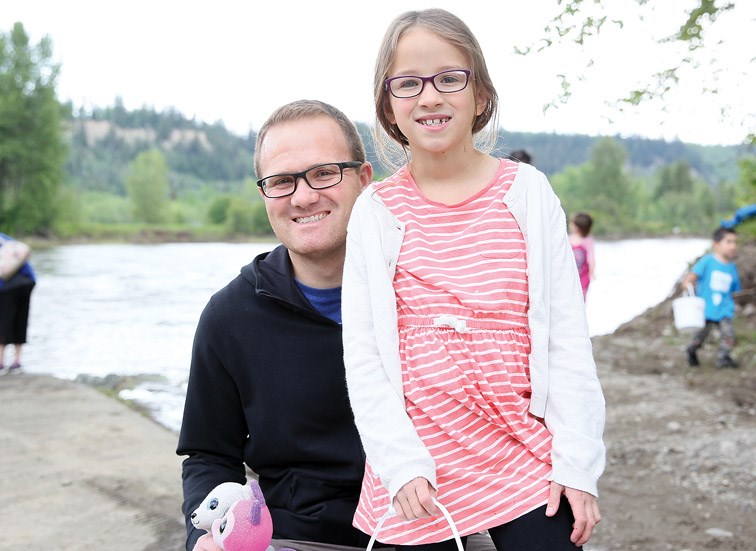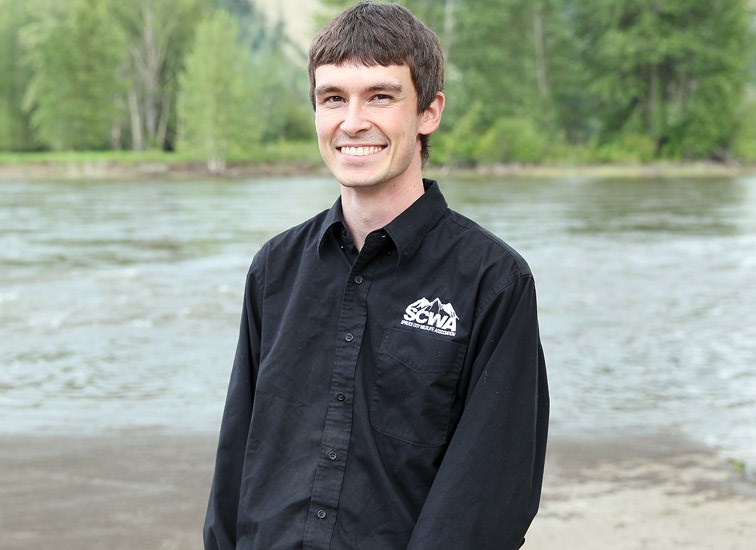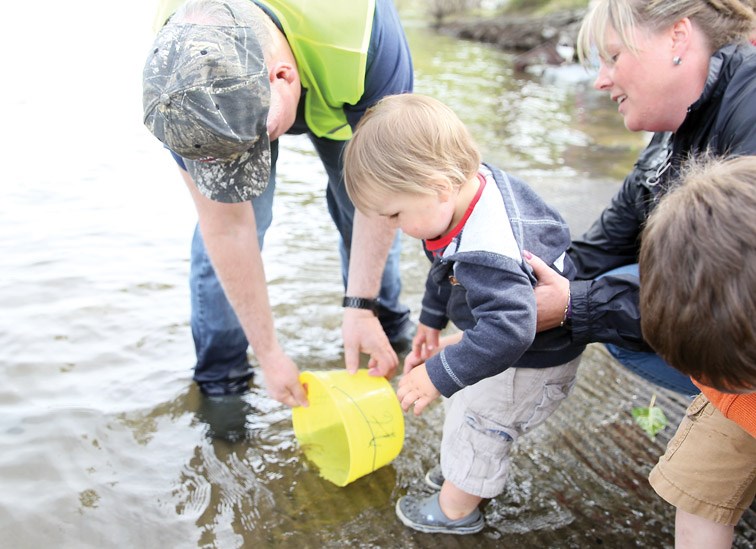Hundreds of fish-minded residents of Prince George released 1,976 Chinook salmon fry into the Nechako River one bucket at a time at the boat launch at Cottonwood Island Park Sunday.
Spruce City Wildlife Association (SCWA) raised the fish from eggs harvested last fall and invited the public to share in the adventure. The association held an open house at the hatchery a short hike from the boat launch where people could enjoy a hot dog and take a tour to see where the salmon lived until release time.
Dan Scott brought his seven-year-old daughter, Naomi, to the event because she is a friend to the furred, the feathered and, yes, even the scaled.
Naomi was delivering her fourth bucket of salmon fry into the Nechako when The Citizen caught up with her.
"I dumped three buckets over there," Naomi said, pointing upriver. "And then I dumped another one over there so no animals will eat them because over there it would be too hard for the animals to reach them."
This isn't Naomi's first fish rodeo.
"Naomi has been here before as her class has visited the fish hatchery," Dan said. "She loves wildlife and animals and I thought it would be a fun thing to do on a Sunday afternoon."
Naomi and Dan were heading over to the fish hatchery where things were going swimmingly.

While the the grill had a host of hot dogs roasting, guests at the hatchery could see a special guest, a skeleton of a female offshore killer whale that was found dead in 1997 floating 31 km off the Tofino coastline. The skeleton is part of the education component for the Spruce City Wildlife Association. The skeleton of '0120 female offshore killer whale' is used as a Build-A-Whale project where people could put vertebrae and ribs where they belonged by matching the numbers on the bones with the numbers on the frame holding the rest of the giant fish.
There is a connection between the killer whale and the local 5-2 salmon stock, which means their life cycle is five years and two years are spent in freshwater.
"The southern resident killer whale is federally listed as a species at risk and they've found that 90 per cent of their diet is Chinook salmon and almost all of that is Interior and Upper Fraser stocks," Dustin Snyder, SCWA vice president, said. "As soon as the salmon hit fresh water they don't eat so our fish have to have way more fat built up while they are in the ocean to make the whole trip. So our Chinook up here have to make the big long trip. So they've actually found that the killer whales - out of an entire school of salmon - they will seek out the ones that are from up here because they are better eating because they've got that fat. There are only 76 southern resident killer whales left. And that's why we brought in the killer whale skeleton - to make that connection with the salmon here."
Visitors to the hatchery could also see where the salmon lived in the tanks, and check out a variety of antlers on the walls of the hatchery and there was an assortment of samples of animal fur that people could touch including black bear, grizzly, white tail deer, moose, mountain goat, caribou, wolf and coyote.
Organizers were pleased with the turnout for the event.

"By the time we were set up this morning we had a big lineup halfway down the park so that was really good," Snyder said. "That was what we were hoping for - getting so many people out shows, in my opinion anyway, a need for this type of thing. Not only on the stewardship side, showing that people care and they want to get involved but on the salmon side of things - our stock is listed as a stock of concern."
That means for the salmon population that exists now, it is unlikely they would rebuild their own numbers in one generation of fish, which is five years.
For return numbers, Snyder said in the wild salmon will return at a rate of one or two per cent, while those that have been released as fry, like those released Sunday, the rate is between two and five per cent.
The stock of area Chinook salmon needs people to help by taking the eggs, keeping them safe until they are fry size and releasing them, explained Snyder.
"We're giving the fish a little kick start, if you will," Snyder said. "Downtown Prince George has both the Fraser and the Nechako, which is two of the biggest watersheds in our whole province and salmon spawning still seems almost foreign to us. It's not at the top of everybody's mind that we have major salmon runs here."
Because the salmon here has been listed as a stock of concern for so long, there hasn't been any fishing opportunities, Snyder added. He said he believes fishing helps to raise awareness and because that doesn't happen, other activities like salmon fry releases and hatchery open houses take place.
Snyder said SWCA has been recently approved by the department of fisheries and oceans to raise 8,000 salmon fry because of the community involvement and the stock's need. The fry will be released the same time next year.
To raise the fry from eggs is volunteer-labour intensive.
"We have them all winter long," Snyder said. "We check them daily and once they're hatched we have people come in five times a day to feed them. We have no paid staff. That is 100 per cent volunteer hours and we are very grateful for all our volunteers."



